Fabrication of Bowl Array Surface-Enhanced Raman Scattering Substrates via Ag Nanoparticle Self-Assembly on Polymer UV-Imprinted Microbowls for Enhanced Raman Detection of Microplastics
Abstract
1. Introduction
2. Fabrication of Microscale Bowl-Shaped Array SERS Substrates
3. Effect of AgNP Coverage Morphology on Substrate Performance
4. Sensitivity Evaluation of Bowl Array SERS Substrates
4.1. R6G Detection on Bowl Array SERS Substrates
4.2. Microplastic (PE) Detection on Bowl Array SERS Substrates
5. Conclusions
Supplementary Materials
Author Contributions
Funding
Institutional Review Board Statement
Data Availability Statement
Conflicts of Interest
Abbreviations
| SERS | Surface-enhanced Raman scattering |
| AgNPs | Silver nanoparticles |
| PDMS | Polydimethylsiloxan |
| PE | Polyethylene |
| PVD | Physical vapor deposition |
| R6G | Rhodamine 6G |
| PVP | Polyvinylpyrrolidone |
| SEM | Scanning electron microscopy |
| LOD | Limit-of-detection |
| EF | Enhancement factor |
References
- Mancuso, M.; Nibali, V.C.; Porcino, N.; Branca, C.; Natale, S.; Smedile, F.; Azzaro, M.; D’Angelo, G.; Bottari, T. Monitoring of anthropogenic microplastic pollution in antarctic fish (emerald rockcod) from the Terranova Bay after a quarter of century. Sci. Total Environ. 2023, 904, 167244. [Google Scholar] [CrossRef] [PubMed]
- Watteau, F.; Dignac, M.-F.; Bouchard, A.; Revallier, A.; Houot, S. Microplastic detection in soil amended with municipal solid waste composts as revealed by transmission electronic microscopy and pyrolysis/GC/MS. Front. Sustain. Food Syst. 2018, 2, 81. [Google Scholar] [CrossRef]
- Reed, C. Dawn of the plasticene age. New Sci. 2015, 225, 28–32. [Google Scholar] [CrossRef]
- Ya, H.; Zhang, T.; Xing, Y.; Lv, M.; Wang, X.; Jiang, B. Co-existence of polyethylene microplastics and tetracycline on soil microbial community and ARGs. Chemosphere 2023, 335, 139082. [Google Scholar] [CrossRef]
- Zhao, J.; Lan, R.; Tan, H.; Wang, J.; Ma, Y.; Chen, Q.; Jiang, F.; Wang, Z.; Xing, B. Detection and characterization of microplastics and nanoplastics in biological samples. Nat. Rev. Bioeng. 2025, 1–15. [Google Scholar] [CrossRef]
- Barceló, D.; Picó, Y.; Alfarhan, A.H. Microplastics: Detection in human samples, cell line studies, and health impacts. Environ. Toxicol. Pharmacol. 2023, 101, 104204. [Google Scholar] [CrossRef]
- Liu, Z.; You, X.-Y. Recent progress of microplastic toxicity on human exposure base on in vitro and in vivo studies. Sci. Total Environ. 2023, 903, 166766. [Google Scholar] [CrossRef]
- Horvatits, T.; Tamminga, M.; Liu, B.; Sebode, M.; Carambia, A.; Fischer, L.; Püschel, K.; Huber, S.; Fischer, E.K. Microplastics detected in cirrhotic liver tissue. EBioMedicine 2022, 82, 104147. [Google Scholar] [CrossRef]
- Massardo, S.; Verzola, D.; Alberti, S.; Caboni, C.; Santostefano, M.; Verrina, E.E.; Angeletti, A.; Lugani, F.; Ghiggeri, G.M.; Bruschi, M. MicroRaman spectroscopy detects the presence of microplastics in human urine and kidney tissue. Environ. Int. 2024, 184, 108444. [Google Scholar] [CrossRef]
- Campen, M.; Nihart, A.; Garcia, M.; Liu, R.; Olewine, M.; Castillo, E.; Bleske, B.; Scott, J.; Howard, T.; Gonzalez-Estrella, J. Bioaccumulation of microplastics in decedent human brains assessed by pyrolysis gas chromatography-mass spectrometry. Res. Sq. 2024. [Google Scholar] [CrossRef]
- Cho, G.; Kim, K.; Chen, W.; Son, S.; Jeon, T.-J.; Kim, S.M. Nanopore detection of sub-nanosized plastics in PE-coated paper cups and analysis of their inflammatory responses. Chem. Eng. J. 2024, 495, 153407. [Google Scholar] [CrossRef]
- Dan, K.-B.; Yoo, J.Y.; Min, H. The emerging threat of micro-and nanoplastics on the maturation and activity of immune cells. Biomol. Ther. 2024, 33, 95. [Google Scholar] [CrossRef] [PubMed]
- Xie, J.; Sun, Y.; Ma, Y.; Wu, D.; Zhang, Z. Blood-brain barrier damage accelerates the accumulation of micro-and nanoplastics in the human central nervous system. J. Hazard. Mater. 2024, 480, 136028. [Google Scholar] [CrossRef] [PubMed]
- Lee, A.; Song, C.; Lee, J.J.; Lee, S.S.; Kang, J.; Kim, K.-T.; Kim, C. Selective detection and tracking of polyamide microplastic by aggregation-promoted fluorescent dye in environmental samples, milk and live organisms. J. Environ. Chem. Eng. 2025, 13, 118100. [Google Scholar] [CrossRef]
- Karakolis, E.G.; Nguyen, B.; You, J.B.; Rochman, C.M.; Sinton, D. Fluorescent dyes for visualizing microplastic particles and fibers in laboratory-based studies. Environ. Sci. Technol. Lett. 2019, 6, 334–340. [Google Scholar] [CrossRef]
- Nigamatzyanova, L.; Fakhrullin, R. Dark-field hyperspectral microscopy for label-free microplastics and nanoplastics detection and identification in vivo: A Caenorhabditis elegans study. Environ. Pollut. 2021, 271, 116337. [Google Scholar] [CrossRef]
- Wang, Z.-M.; Wagner, J.; Ghosal, S.; Bedi, G.; Wall, S. SEM/EDS and optical microscopy analyses of microplastics in ocean trawl and fish guts. Sci. Total Environ. 2017, 603, 616–626. [Google Scholar] [CrossRef] [PubMed]
- Veerasingam, S.; Ranjani, M.; Venkatachalapathy, R.; Bagaev, A.; Mukhanov, V.; Litvinyuk, D.; Mugilarasan, M.; Gurumoorthi, K.; Guganathan, L.; Aboobacker, V. Contributions of Fourier transform infrared spectroscopy in microplastic pollution research: A review. Crit. Rev. Environ. Sci. Technol. 2021, 51, 2681–2743. [Google Scholar] [CrossRef]
- Nakano, R.; Gürses, R.K.; Tanaka, Y.; Ishida, Y.; Kimoto, T.; Kitagawa, S.; Iiguni, Y.; Ohtani, H. Pyrolysis-GC–MS analysis of ingested polystyrene microsphere content in individual Daphnia magna. Sci. Total Environ. 2022, 817, 152981. [Google Scholar] [CrossRef]
- Dang, T.T.; Sogut, E.; Uysal-Unalan, I.; Corredig, M. Quantification of polystyrene microplastics in water, milk, and coffee using thermogravimetry coupled with fourier transform infrared spectroscopy (TGA-FTIR). Chemosphere 2024, 368, 143777. [Google Scholar] [CrossRef]
- Dümichen, E.; Barthel, A.-K.; Braun, U.; Bannick, C.G.; Brand, K.; Jekel, M.; Senz, R. Analysis of polyethylene microplastics in environmental samples, using a thermal decomposition method. Water Res. 2015, 85, 451–457. [Google Scholar] [CrossRef] [PubMed]
- Zhang, Y.; Fu, Z.; Wang, W.; Ji, G.; Zhao, M.; Li, A. Kinetics, product evolution, and mechanism for the pyrolysis of typical plastic waste. ACS Sustain. Chem. Eng. 2021, 10, 91–103. [Google Scholar] [CrossRef]
- Lv, L.; He, L.; Jiang, S.; Chen, J.; Zhou, C.; Qu, J.; Lu, Y.; Hong, P.; Sun, S.; Li, C. In situ surface-enhanced Raman spectroscopy for detecting microplastics and nanoplastics in aquatic environments. Sci. Total Environ. 2020, 728, 138449. [Google Scholar] [CrossRef] [PubMed]
- Dąbrowska, A.; Mielańczuk, M.; Syczewski, M. The Raman spectroscopy and SEM/EDS investigation of the primary sources of microplastics from cosmetics available in Poland. Chemosphere 2022, 308, 136407. [Google Scholar] [CrossRef] [PubMed]
- Wu, Q.; Xiao, D.; Wang, N.; Masia, F.; Langbein, W.; Li, B. Rapid identification of micro and nanoplastics by line scan Raman micro-spectroscopy. Talanta 2024, 266, 125067. [Google Scholar] [CrossRef]
- Shiwani, S.; Latka, I.; Popp, J.; Krafft, C.; Schie, I.W. Rapid Microplastic Detection Using High-Throughput Screening Raman Spectroscopy. ACS Omega 2025, 10, 33675–33688. [Google Scholar] [CrossRef]
- Xu, D.; Su, W.; Lu, H.; Luo, Y.; Yi, T.; Wu, J.; Wu, H.; Yin, C.; Chen, B. A gold nanoparticle doped flexible substrate for microplastics SERS detection. Phys. Chem. Chem. Phys. 2022, 24, 12036–12042. [Google Scholar] [CrossRef]
- Di, Z.; Gao, J.; Li, J.; Zhou, H.; Jia, C. Quantitative analysis of microplastics in seawater based on SERS internal standard method. Anal. Methods 2024, 16, 1887–1893. [Google Scholar] [CrossRef]
- Li, Z.; Ding, Z.; Yan, Z.; Han, K.; Zhang, M.; Zhou, H.; Sun, X.; Sun, H.; Li, J.; Zhang, W. NiO/AgNPs nanowell enhanced SERS sensor for efficient detection of micro/nanoplastics in beverages. Talanta 2025, 281, 126877. [Google Scholar] [CrossRef]
- Ly, N.H.; Nguyen, T.H.; Nghi, N.Đ.; Kim, Y.-H.; Joo, S.-W. Surface-Enhanced Raman Scattering Detection of Fipronil Pesticide Adsorbed on Silver Nanoparticles. Sensors 2019, 19, 1355. [Google Scholar] [CrossRef]
- Li, Z.; Han, K.; Zhang, A.; Wang, T.; Yan, Z.; Ding, Z.; Shen, Y.; Zhang, M.; Zhang, W. Honeycomb-like AgNPs@TiO2 array SERS sensor for the quantification of micro/nanoplastics in the environmental water samples. Talanta 2024, 266, 125070. [Google Scholar] [CrossRef] [PubMed]
- Zhang, H.; Yang, S.; Zhou, Q.; Yang, L.; Wang, P.; Fang, Y. The suitable condition of using LSPR model in SERS: LSPR effect versus chemical effect on microparticles surface-modified with nanostructures. Plasmonics 2017, 12, 77–81. [Google Scholar] [CrossRef]
- Jeon, T.Y.; Kim, D.J.; Park, S.-G.; Kim, S.-H.; Kim, D.-H. Nanostructured plasmonic substrates for use as SERS sensors. Nano Converg. 2016, 3, 18. [Google Scholar] [CrossRef]
- Zhu, Z.; Han, K.; Feng, Y.; Li, Z.; Zhang, A.; Wang, T.; Zhang, M.; Zhang, W. Biomimetic Ag/ZnO@ PDMS hybrid nanorod array-mediated photo-induced enhanced Raman spectroscopy sensor for quantitative and visualized analysis of microplastics. ACS Appl. Mater. Interfaces 2023, 15, 36988–36998. [Google Scholar] [CrossRef]
- Lê, Q.T.; Ly, N.H.; Kim, M.-K.; Lim, S.H.; Son, S.J.; Zoh, K.-D.; Joo, S.-W. Nanostructured Raman substrates for the sensitive detection of submicrometer-sized plastic pollutants in water. J. Hazard. Mater. 2021, 402, 123499. [Google Scholar] [CrossRef]
- Liu, X.; Li, R.; Shi, M.; Zhou, N.; Yang, S.; Yang, H.; Mao, H. Light Trapping-Assisted Nanofiber Surface-Enhanced Raman Scattering Substrates with High Absorption for Biochemical Sensing. ACS Appl. Nano Mater. 2025, 8, 4658–4669. [Google Scholar] [CrossRef]
- Li, W.; Xiong, L.; Li, N.; Pang, S.; Xu, G.; Yi, C.; Wang, Z.; Gu, G.; Li, K.; Li, W. Tunable 3D light trapping architectures based on self-assembled SnSe 2 nanoplate arrays for ultrasensitive SERS detection. J. Mater. Chem. C 2019, 7, 10179–10186. [Google Scholar] [CrossRef]
- Xu, G.; Dong, R.; Gu, D.; Tian, H.; Xiong, L.; Wang, Z.; Wang, W.; Shao, Y.; Li, W.; Li, G. Selenium vacancies and synergistic effect of near-and far-field-enabled ultrasensitive surface-enhanced raman-scattering-active substrates for malaria detection. J. Phys. Chem. Lett. 2022, 13, 1453–1463. [Google Scholar] [CrossRef]
- Pei, J.; Tian, Z.; Yu, X.; Zhang, S.; Ma, S.; Sun, Y.; Boukherroub, R. Highly-sensitive SERS detection of tetracycline: Sub-enhancement brought by light scattering of nano-diamond. Appl. Surf. Sci. 2023, 608, 155270. [Google Scholar] [CrossRef]
- Yuan, Y.; Lin, Y.; Gu, B.; Panwar, N.; Tjin, S.C.; Song, J.; Qu, J.; Yong, K.-T. Optical trapping-assisted SERS platform for chemical and biosensing applications: Design perspectives. Coord. Chem. Rev. 2017, 339, 138–152. [Google Scholar] [CrossRef]
- Lin, C.-H.; Chen, Y.-C.; Wang, K.-S.; Yueh, D.-J.; Yeh, S.-H.; Chen, J.-S.; Cheng, Y.-H.; Wang, Y.-L.; Liu, T.-Y. Light-capture capability based flexible negative pyramid microarrays coated with silver nano-islands for SERS detection. Chem. Eng. J. 2025, 523, 168060. [Google Scholar] [CrossRef]
- Kousheh, S.; Hajikhani, M.; Asgari, S.; Lin, M. Detection of micro- and nanoplastic particles in leafy green vegetables by SERS coupled with gold-silver core–shell nanoparticles. Microchim. Acta 2024, 191, 755. [Google Scholar] [CrossRef] [PubMed]
- Jun, E.S.; Choe, J.H.; Kim, J.S.; Ahn, D.W.; Yoo, J.; Choi, T.M.; Pyo, S.G. Quantitative Raman analysis of microplastics in water using peak area ratios for concentration determination. npj Clean Water 2024, 7, 104. [Google Scholar] [CrossRef]
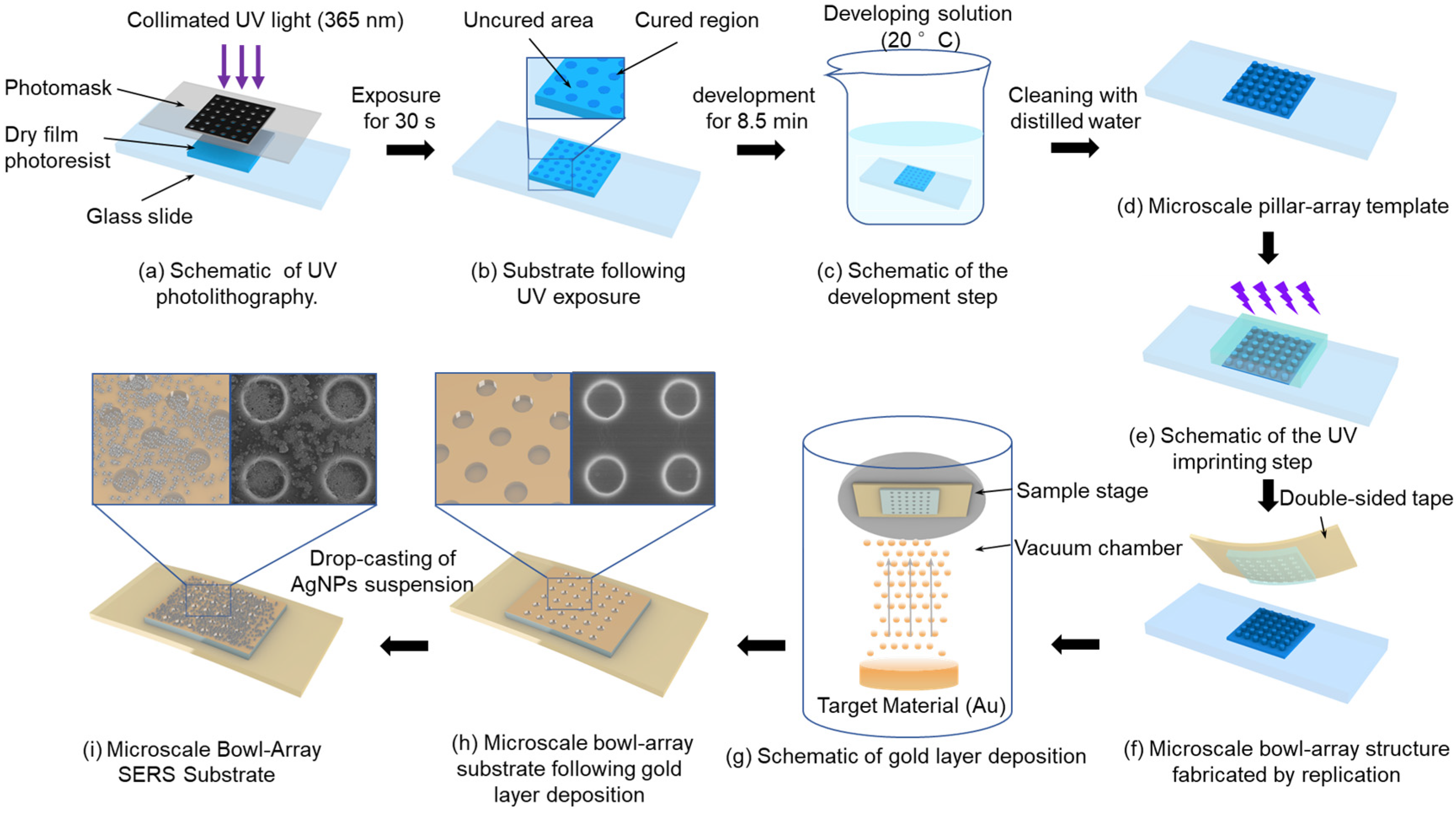





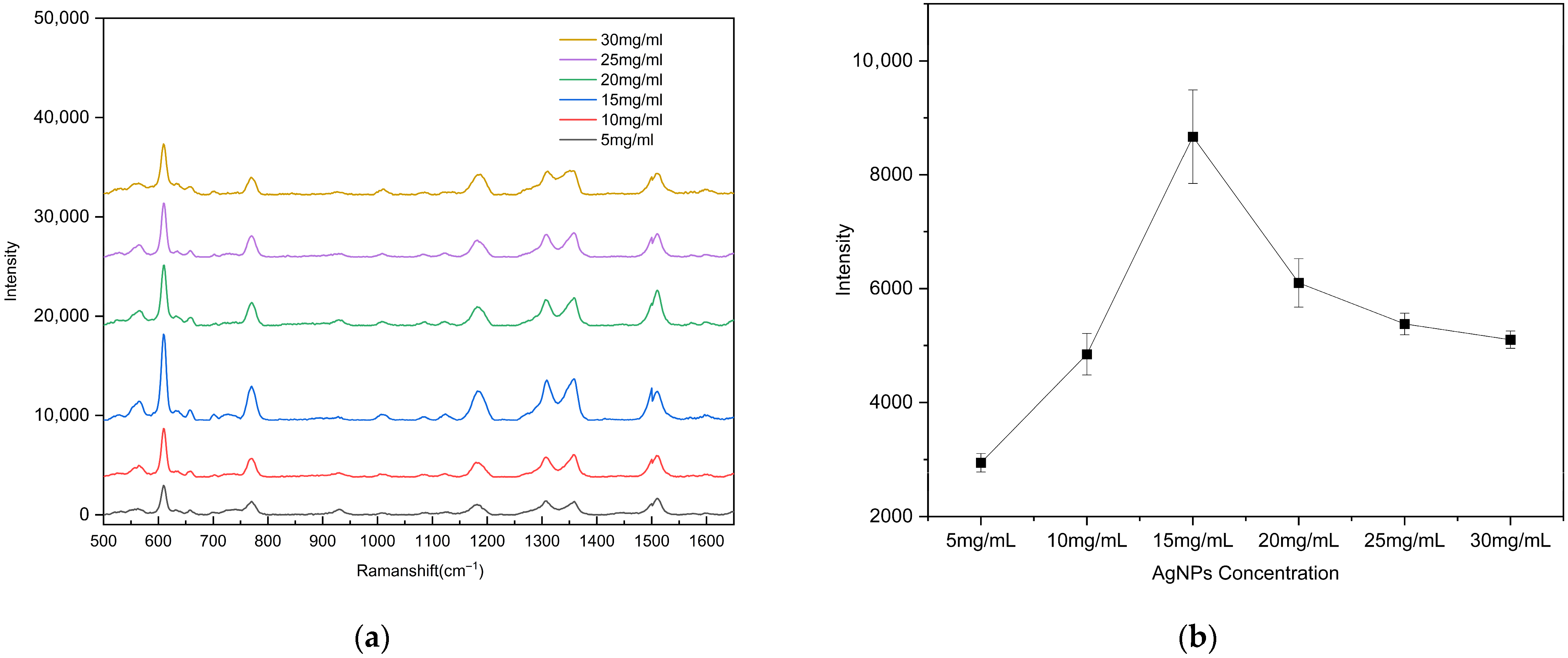
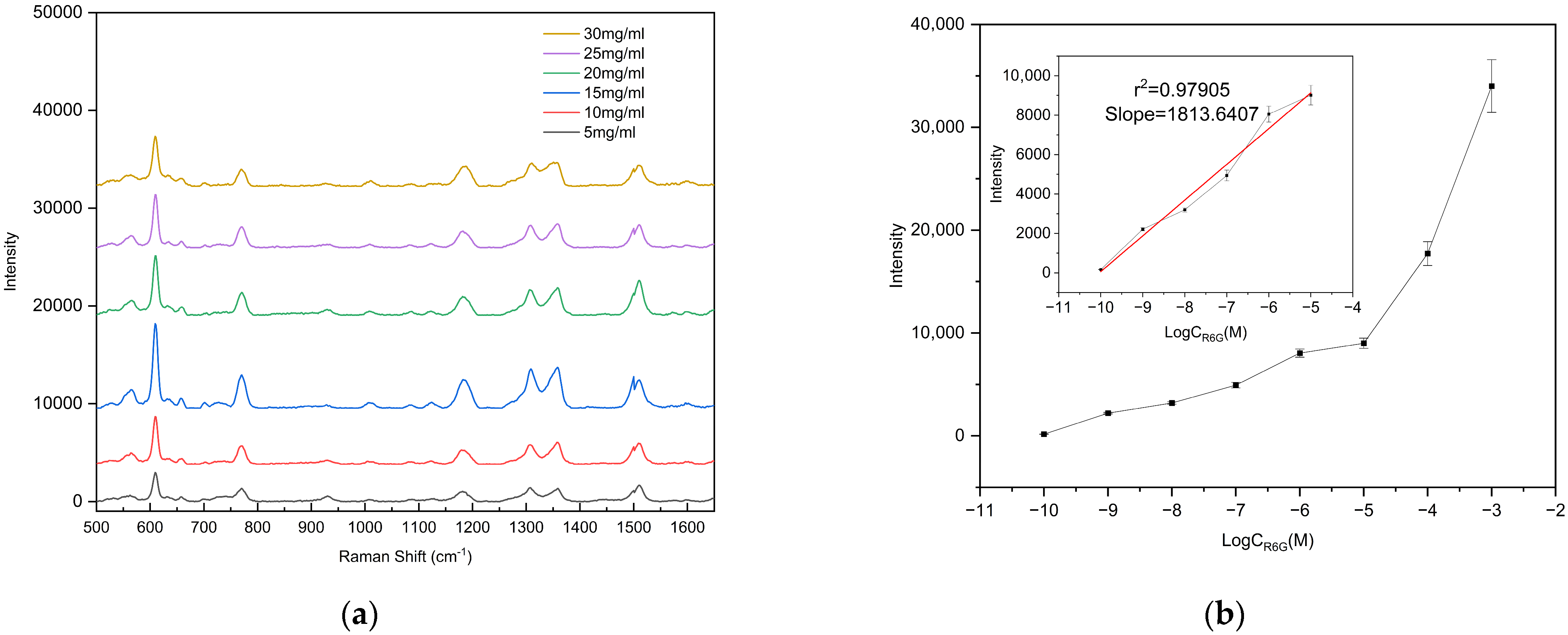
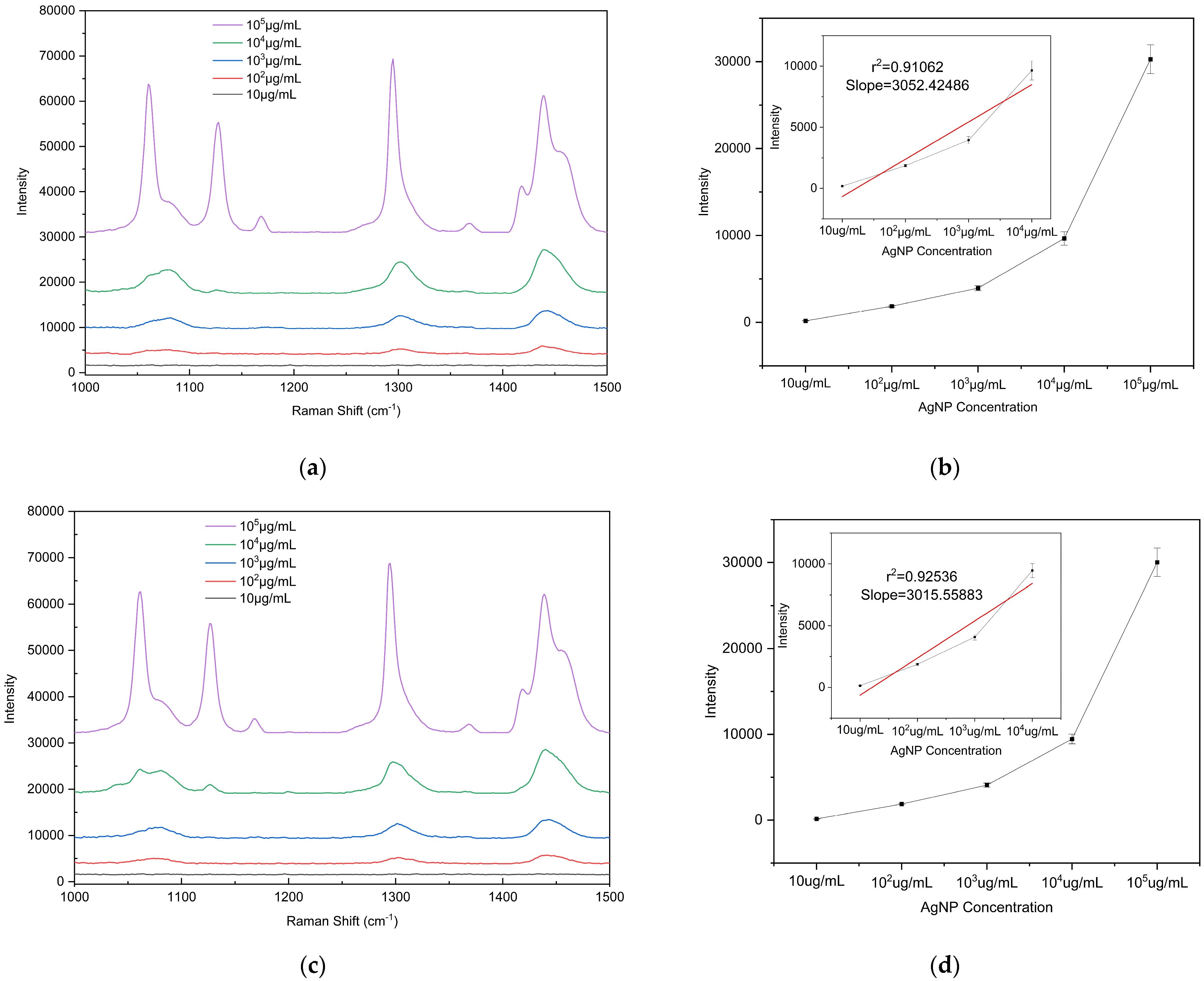
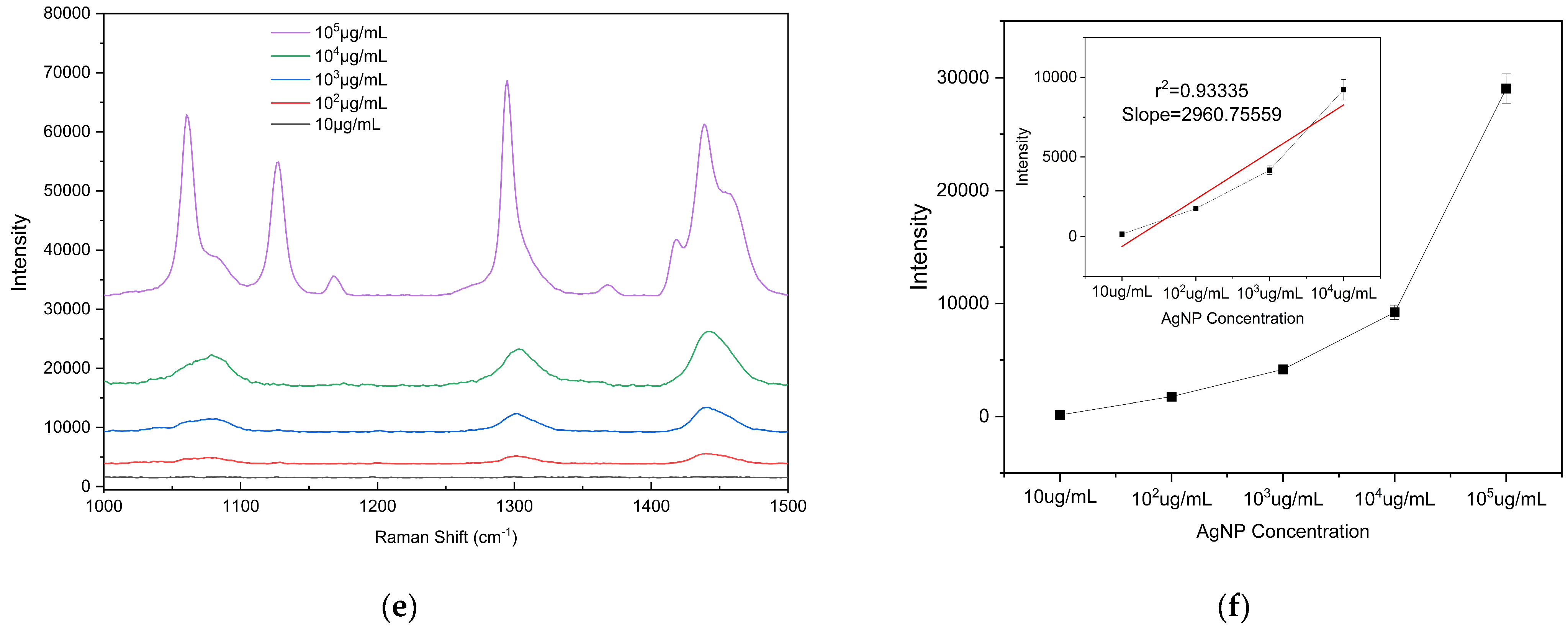
Disclaimer/Publisher’s Note: The statements, opinions and data contained in all publications are solely those of the individual author(s) and contributor(s) and not of MDPI and/or the editor(s). MDPI and/or the editor(s) disclaim responsibility for any injury to people or property resulting from any ideas, methods, instructions or products referred to in the content. |
© 2025 by the authors. Licensee MDPI, Basel, Switzerland. This article is an open access article distributed under the terms and conditions of the Creative Commons Attribution (CC BY) license (https://creativecommons.org/licenses/by/4.0/).
Share and Cite
Liu, Y.; Qi, L.; Guo, K.; Ning, X.; Huang, Y.; Lu, X. Fabrication of Bowl Array Surface-Enhanced Raman Scattering Substrates via Ag Nanoparticle Self-Assembly on Polymer UV-Imprinted Microbowls for Enhanced Raman Detection of Microplastics. Polymers 2025, 17, 2930. https://doi.org/10.3390/polym17212930
Liu Y, Qi L, Guo K, Ning X, Huang Y, Lu X. Fabrication of Bowl Array Surface-Enhanced Raman Scattering Substrates via Ag Nanoparticle Self-Assembly on Polymer UV-Imprinted Microbowls for Enhanced Raman Detection of Microplastics. Polymers. 2025; 17(21):2930. https://doi.org/10.3390/polym17212930
Chicago/Turabian StyleLiu, Yihong, Longchao Qi, Kaibo Guo, Xianlong Ning, Yiming Huang, and Xun Lu. 2025. "Fabrication of Bowl Array Surface-Enhanced Raman Scattering Substrates via Ag Nanoparticle Self-Assembly on Polymer UV-Imprinted Microbowls for Enhanced Raman Detection of Microplastics" Polymers 17, no. 21: 2930. https://doi.org/10.3390/polym17212930
APA StyleLiu, Y., Qi, L., Guo, K., Ning, X., Huang, Y., & Lu, X. (2025). Fabrication of Bowl Array Surface-Enhanced Raman Scattering Substrates via Ag Nanoparticle Self-Assembly on Polymer UV-Imprinted Microbowls for Enhanced Raman Detection of Microplastics. Polymers, 17(21), 2930. https://doi.org/10.3390/polym17212930






